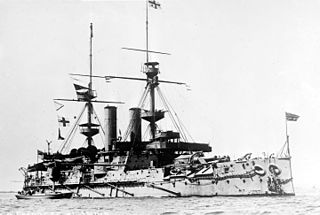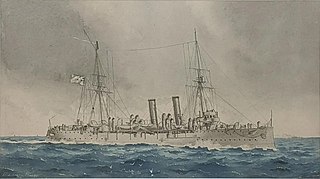
HMS Magnificent was one of the nine Majestic-class pre-dreadnought battleships of the Royal Navy. She entered service in late 1895 with the Channel Fleet, remaining with the fleet through its subsequent reorganisation into the Atlantic Fleet. In 1905, an explosion caused the deaths of 18 men but she remained in service until 1906, after which she underwent a refit. She served with the Home Fleet for most of her pre-war service.

HMS Resolution was a Royal Sovereign-class pre-dreadnought battleship of the Royal Navy. The ship was built by Palmers Shipbuilding and Iron Company, starting with her keel laying in June 1890. She was launched in May 1892 and, after completing trials, was commissioned into the Channel Squadron the following December. She was armed with a main battery of four 13.5-inch guns and a secondary battery of ten 6-inch guns. The ship had a top speed of 16.5 knots.

HMS Hyacinth was one of three Highflyer-class protected cruisers built for the Royal Navy in the 1890s. Initially assigned to the Channel Fleet, she spent much of her early career as flagship for the East Indies Station. She was reduced to reserve in 1912 after a lengthy refit before becoming the flagship of the Cape of Good Hope Station in 1913. After the beginning of World War I in August 1914, she spent the first few months of the war escorting convoys around South Africa. In early 1915, she was deployed to German East Africa to blockade the German light cruiser SMS Königsberg. She destroyed a German blockade runner attempting to bring supplies through the blockade in April and sank a German merchant vessel in early 1916. Hyacinth remained on the Cape Station for the rest of the war and was paid off in 1919, although she was not sold for scrap until 1923.

The Pelorus-class cruiser was a "third-class" protected cruiser class of eleven Royal Navy warships designed by Sir William White, based on the earlier Pearl-class cruisers. They were ordered in 1893 under the Spencer Programme, and laid down 1896–1900. The first, HMS Pelorus, was commissioned in 1896.

HMS Pelorus was the first of the Pelorus-class cruiser, and was laid down at Sheerness dockyard in 1896. Completed and commissioned into the Royal Navy on 15 December the same year, she was designed by Sir William White. Construction cost £154,315. The ship was well armed for her size, but was primarily a workhorse for the overseas fleet.

HMCS Rainbow was an Apollo-class protected cruiser built for Great Britain's Royal Navy as HMS Rainbow entering service in 1892. Rainbow saw time in Asian waters before being placed in reserve in 1909. In 1910 the cruiser was transferred to the Royal Canadian Navy for service on the west coast. At the outbreak of the First World War, Rainbow was the only major Commonwealth warship on the western coast of North America. Due to age, the cruiser was taken out of service in 1917 and sold for scrap in 1920 and broken up.

HMS Doris was an Eclipse-class protected cruiser built for the Royal Navy in the mid-1890s.

HMS Hannibal was a Majestic-class pre-dreadnought battleship built for the Royal Navy, and the sixth ship to bear the name HMS Hannibal. The ship was laid down at the Pembroke Dock in May 1894, she was launched in April 1896, and commissioned into the fleet in April 1898. She was armed with a main battery of four 12-inch (305 mm) guns and a secondary battery of twelve 6-inch (152 mm) guns. The ship had a top speed of 16 knots.

HMS Andromeda was one of eight Diadem-class protected cruisers built for the Royal Navy in the 1890s. Upon completion in 1899, the ship was assigned to the Mediterranean Fleet where she helped to escort a royal yacht during its cruise through the Mediterranean Sea. After a refit, she was assigned to the China Station in 1904 and returned home three years later to be reduced to reserve. Andromeda was converted into a training ship in 1913 and remained in that role under various names until 1956. That year she was sold for scrap and broken up in Belgium, the last Pembroke-built ship still afloat.

HMS Immortalité was one of seven Orlando-class armoured cruisers built for the Royal Navy in the mid-1880s. She was sold for scrap on 11 January 1907.

HMS Aurora was one of seven Orlando-class armoured cruisers built for the Royal Navy in the mid-1880s. The ship spent a brief time in reserve before she was assigned to the Channel Squadron for two years in 1890. In 1893 Aurora became a coast guard ship in Ireland for two years before she was placed in reserve again. The ship recommissioned in 1899 for service on the China Station and some of her crew participated in the Battle of Tientsin in 1900 during the Boxer Rebellion. Aurora returned home two years later and was again reduced to reserve. She was taken out of service in 1905 and sold for scrap on 2 October 1907.

HMS Empress of India was one of seven Royal Sovereign-class pre-dreadnought battleships built for the Royal Navy during the 1890s. The ship was commissioned in 1893 and served as the flagship of the second-in-command of the Channel Fleet for two years. She was transferred to the Mediterranean Fleet in 1897, during which time Empress of India was assigned to the International Squadron blockading Crete during the uprising there. She returned home in 1901 and was briefly assigned as a coast guard ship in Ireland before she became the second flagship of the Home Fleet. The ship was reduced to reserve in 1905 and accidentally collided with the submarine HMS A10 the following year. Empress of India was taken out of service in early 1912 and accidentally struck a German sailing ship while under tow. She was sunk as a target ship in 1913.

HMS Charger was a Charger-class destroyer which served with the Royal Navy. She was launched by Yarrow Shipbuilders at Poplar, London on 15 September 1894, served in home waters and was sold off in 1912.

HMS Pyramus was aPelorus-class protected cruiser of the Royal Navy. There were eleven "Third class" protected cruisers in the class, which was designed by Sir William White. While well armed for their size, they were primarily workhorses for the overseas fleet on "police" duties and did not serve with the main battlefleet.
HMS Perseus was a Pelorus-class protected cruiser of the Royal Navy. There were eleven "Third class" protected cruisers in the class, which was designed by Sir William White. They mainly served at overseas stations rather than with the main fleets.

HMS Pactolus was a Pelorus-class protected cruiser of the Royal Navy. There were eleven ""Third class"" protected cruisers in the class, which was designed by Sir William White. While well armed for their size, they were primarily workhorses for the overseas fleet on "police" duties and did not serve with the main battlefleet. She was scrapped in 1921.

The Arrogant-class cruiser was a class of four protected cruisers built for the British Royal Navy at the end of the 1890s. One ship, HMS Gladiator, was lost following a collision with a merchant ship in 1908, while HMS Vindictive saw active service in the First World War, taking part in the Zeebrugge Raid in April 1918 before being sunk as a blockship during the Second Ostend Raid in May 1918.

HMS Venus was an Eclipse-class protected cruiser built for the Royal Navy in the mid-1890s.

HMS Isis was an Eclipse-class protected cruiser built for the Royal Navy in the mid-1890s.

HMS Dido was an Eclipse-class protected cruiser built for the Royal Navy in the mid-1890s.


















